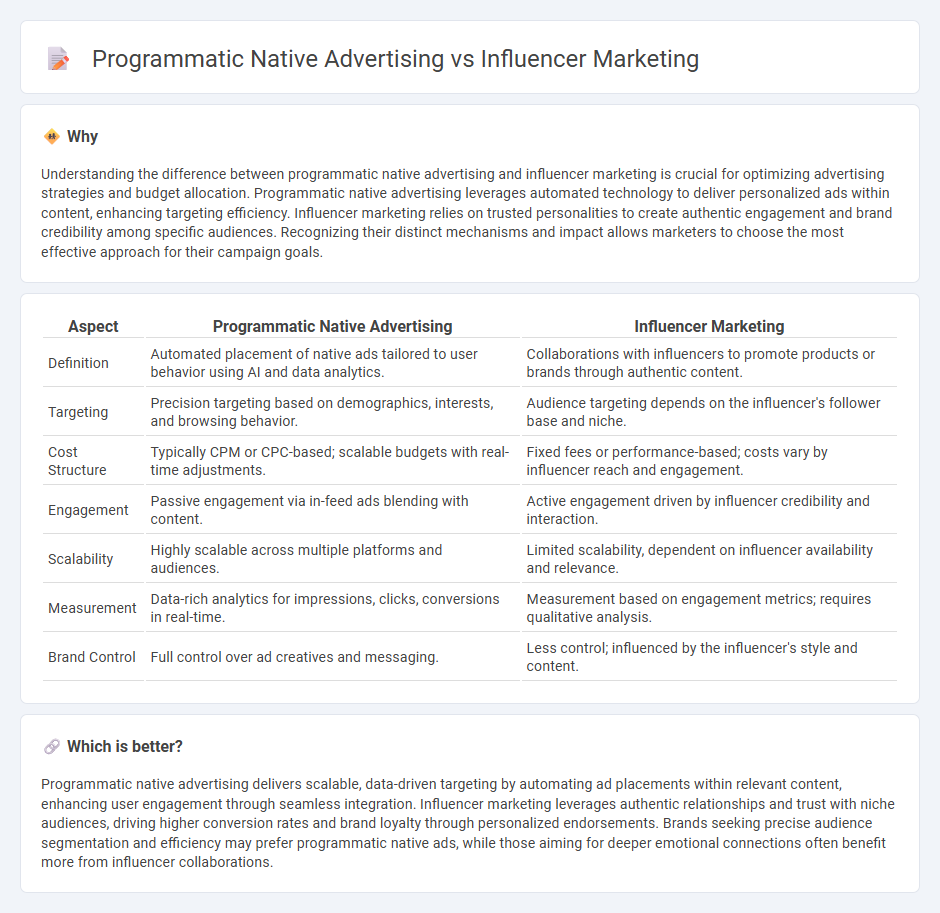
Programmatic native advertising utilizes automated technology to deliver personalized, contextually relevant ads seamlessly integrated into digital content, enhancing user engagement and driving conversions. Influencer marketing leverages individuals with established audience trust and niche authority to promote brands authentically through social media platforms. Explore deeper insights on how these marketing strategies can optimize your campaign effectiveness.
Why it is important
Understanding the difference between programmatic native advertising and influencer marketing is crucial for optimizing advertising strategies and budget allocation. Programmatic native advertising leverages automated technology to deliver personalized ads within content, enhancing targeting efficiency. Influencer marketing relies on trusted personalities to create authentic engagement and brand credibility among specific audiences. Recognizing their distinct mechanisms and impact allows marketers to choose the most effective approach for their campaign goals.
Comparison Table
| Aspect | Programmatic Native Advertising | Influencer Marketing |
|---|---|---|
| Definition | Automated placement of native ads tailored to user behavior using AI and data analytics. | Collaborations with influencers to promote products or brands through authentic content. |
| Targeting | Precision targeting based on demographics, interests, and browsing behavior. | Audience targeting depends on the influencer's follower base and niche. |
| Cost Structure | Typically CPM or CPC-based; scalable budgets with real-time adjustments. | Fixed fees or performance-based; costs vary by influencer reach and engagement. |
| Engagement | Passive engagement via in-feed ads blending with content. | Active engagement driven by influencer credibility and interaction. |
| Scalability | Highly scalable across multiple platforms and audiences. | Limited scalability, dependent on influencer availability and relevance. |
| Measurement | Data-rich analytics for impressions, clicks, conversions in real-time. | Measurement based on engagement metrics; requires qualitative analysis. |
| Brand Control | Full control over ad creatives and messaging. | Less control; influenced by the influencer's style and content. |
Which is better?
Programmatic native advertising delivers scalable, data-driven targeting by automating ad placements within relevant content, enhancing user engagement through seamless integration. Influencer marketing leverages authentic relationships and trust with niche audiences, driving higher conversion rates and brand loyalty through personalized endorsements. Brands seeking precise audience segmentation and efficiency may prefer programmatic native ads, while those aiming for deeper emotional connections often benefit more from influencer collaborations.
Connection
Programmatic native advertising and influencer marketing intersect through their shared goal of delivering personalized, engaging content that resonates with targeted audiences. Both leverage data-driven insights and audience segmentation to optimize campaign reach and effectiveness, enhancing consumer trust and brand authenticity. Integrating programmatic technology with influencer partnerships amplifies real-time content distribution across multiple digital platforms, maximizing marketing ROI.
Key Terms
Authenticity
Influencer marketing leverages genuine personalities to create authentic connections with target audiences, often resulting in higher trust and engagement rates compared to programmatic native advertising, which relies on automated placement of sponsored content. Authenticity in influencer campaigns stems from relatable endorsements and real-life experiences, while programmatic native ads can sometimes appear intrusive or less personalized. Explore deeper insights on how authenticity shapes effectiveness in these advertising strategies.
Automation
Influencer marketing leverages human creativity and relationships, whereas programmatic native advertising relies on AI-driven automation to optimize ad placements across digital platforms in real-time. Automation in programmatic native advertising enables precise audience targeting and efficient budget allocation, outperforming manual influencer negotiations in scalability and data-driven insights. Explore how automation transforms digital campaigns by enhancing efficiency and targeting precision.
Targeting
Influencer marketing targets niche audiences through authentic, content-driven engagements on platforms like Instagram and TikTok, leveraging personalities that resonate with specific demographics. Programmatic native advertising uses AI-driven algorithms to deliver personalized ads in real-time across multiple websites, optimizing reach based on user behavior and contextual data. Explore the nuances of targeting strategies to determine which approach best aligns with your marketing goals.
Source and External Links
Influencer marketing - Wikipedia - Influencer marketing is a form of social media marketing involving endorsements from influencers with expert knowledge or social influence who promote brands on platforms like Instagram, YouTube, and TikTok, shaping consumer behavior and requiring transparency about sponsored content.
What Is Influencer Marketing? - Mailchimp - Influencer marketing enables brands to collaborate with individuals who have a following for brand exposure, involving strategic goal setting, audience alignment, budgeting, and often ongoing partnerships with influencers for best results.
Influencer Marketing and Why It's Important Today - Influencer marketing leverages credible experts on social media to create authentic endorsements that build trust with targeted audiences, especially as consumer trust in traditional ads declines and online shopping grows rapidly.
 dowidth.com
dowidth.com